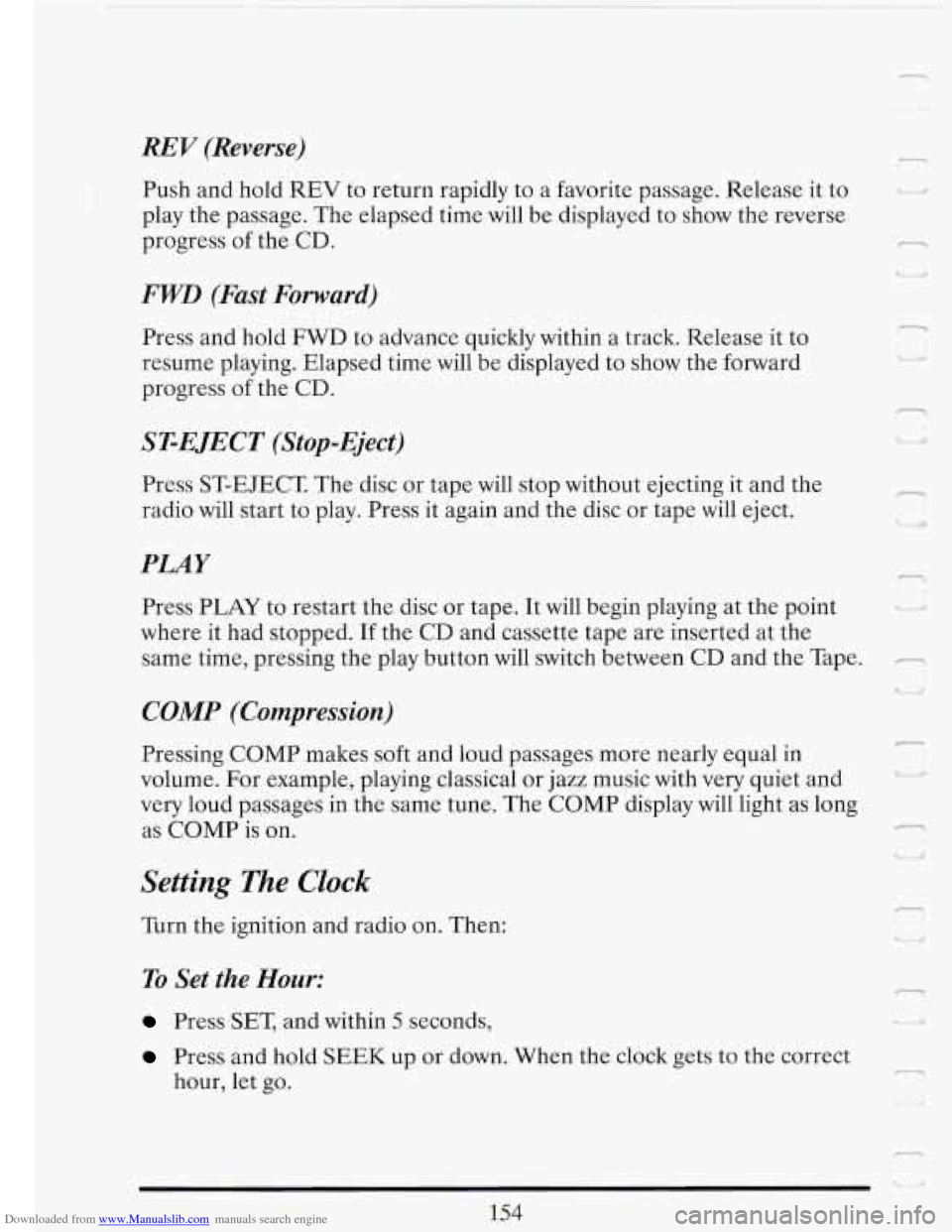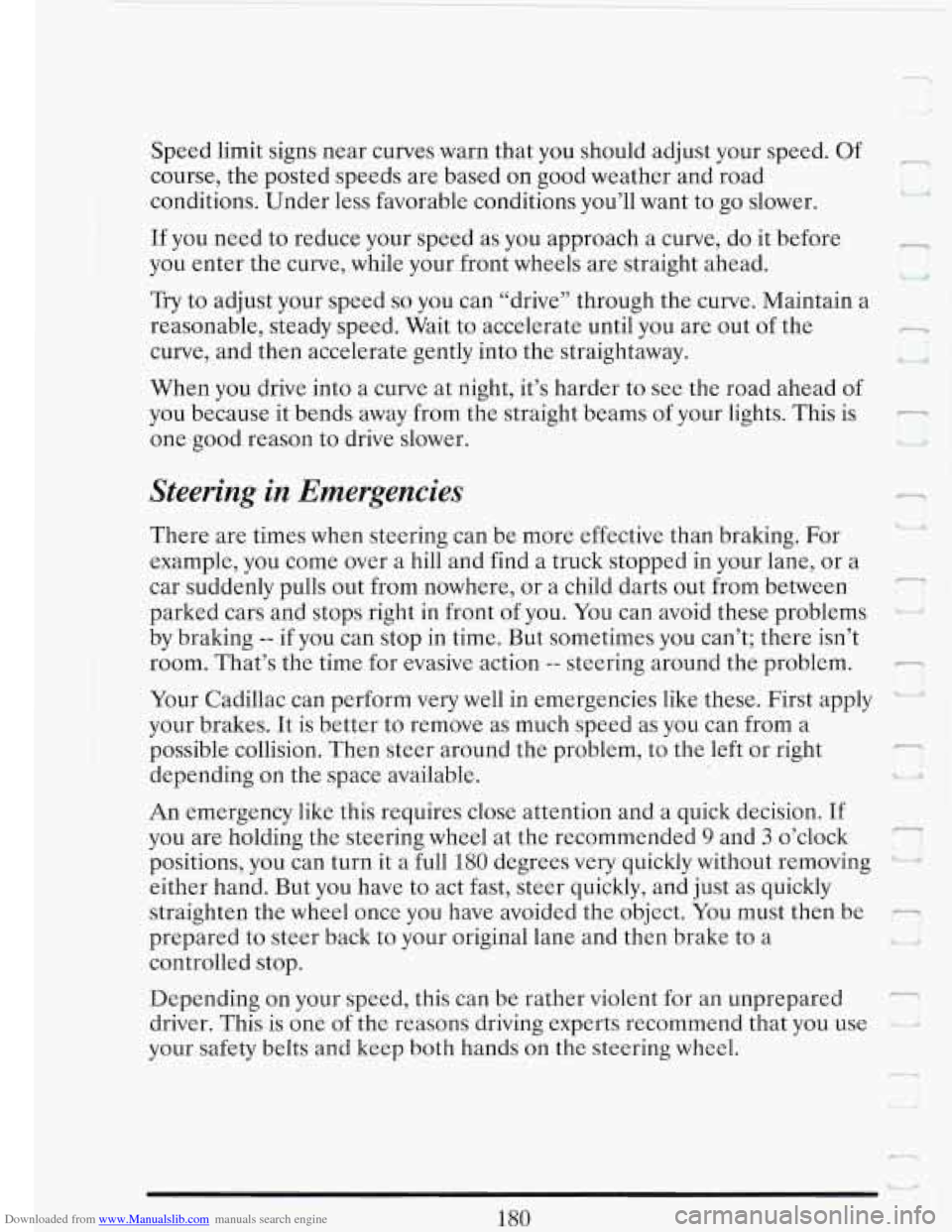Page 86 of 386
Downloaded from www.Manualslib.com manuals search engine You can match a transmitter to as many different vehicles as you own,
provided they are equipped with exactlv the same model svstem. (General
Motors offers several different models of these systems on their vehicles.)
Each vehicle can have only
2 transmitters matched to it.
See your dealer to match transmitters to another vehicle.
Battery Replacement
Under normal use, the batteries in your key chain transmitter should last
about
two years.
You can tell the batteries are weak if the transmitter won't work at the
normal range in any location. If you have to get close to your vehicle
before the transmitter works, it's probably time to change the batteries.
I
1. Use round end of
the door key, or a
quarter to rotate
cover
counterclockwise
1/16 of a turn.
1
U
r-"
72
Page 88 of 386
Downloaded from www.Manualslib.com manuals search engine I
,
cover and
transmitter and
u
rotate clockwise to
4. Align notches on
reinstall.
I
B
74
Page 168 of 386

Downloaded from www.Manualslib.com manuals search engine - t
REV (Reverse)
Push and hold REV to return rapidly to a favorite passage. Release it to
play the passage. The elapsed time will be displayed to show the reverse
progress of the
CD.
FWD (Fast Forward)
Press and hold FWD to advance quickly within a track. Release it to
resume playing. Elapsed time will be displayed to show the forward
progress
of the CD.
ST-EJECT (Stop-Eject)
Press ST-EJECT The disc or tape will stop without ejecting it and the
radio will start to play. Press it again and the disc
or tape will eject.
PLAY
Press PLAY to restart the disc or tape. It will begin playing at the point
where it had stopped. If the CD and cassette tape are inserted at the
same time, pressing the play button will switch between CD and the Tape.
COMP (Compression)
r-) U
1 I. L
Pressing COMP makes soft and loud passages more nearly equal in
volume. For example, playing classical or jazz music with very quiet and
very loud passages in the same tune. The COMP display will light as long
as COMP
is on. E
Setting The Clock
Turn the ignition and radio on. Then:
To Set the Hour:
Press SET, and within 5 seconds,
"I Lr/ 'i
Press and hold SEEK up or down. When the clock gets to the correct
hour, let go. -
Page 169 of 386

Downloaded from www.Manualslib.com manuals search engine r
C.
To Set the Minutes:
0 Press SET, and within 5 seconds,
0 Press and hold SCAN up or down. When the clock gets to the correct
minute, let go.
Your clock is set.
Care of Your Cassette Tape Player
A tape player that is not cleaned regularly can cause reduced sound
quality, ruined cassettes, or a damaged mechanism. Cassette tapes should
be stored in their cases away from contaminants, direct sunlight, and
extreme heat.
If they aren’t, they may not operate properly or cause
failure
of the tape player.
Your tape player should be cleaned regularly each month or after every
15 hours of use. If you notice a reduction in sound quality, try a known
good cassette to see if the tape or the tape player is at fault.
If this other
cassette has no improvement in sound quality, clean the tape player.
Clean your tape player with a wiping-action, non-abrasive cleaning
cassette, and follow the directions provided with it.
~
Cassettes are subject to wear and the sound quality may degrade over
time. Always make sure that the cassette tape is in good condition before
you have your tape player serviced.
Care of Your Compact Discs
Handle discs carefully. Store them in their original cases or other
protective cases and away from direct sunlight and dust.
If the surface of
- a disc is soiled, dampen a clean, soft cloth in a mild, neutral detergent
solution and clean it, wiping from the center to the edge.
Be sure never to touch the signal surface
when handling discs. Pick up
edge.
I discs by grasping the outer edges or the edge of the hole and the outer
7 Power Antenna Mast Care
Your power antenna will look its best and work well if it’s cleaned from
time to time.
155
Page 194 of 386

Downloaded from www.Manualslib.com manuals search engine c 1
Speed limit signs near curves warn that you should adjust your speed. Of
course, the posted speeds are based on good weather and road
conditions. Under less favorable conditions you’ll want to go slower.
If you need to reduce your speed as you approach a curve, do it before
you enter the curve, while your front wheels are straight ahead.
Try to adjust your speed so you can “drive” through the curve. Maintain a
reasonable, steady speed. Wait to accelerate until you are out of the
curve, and then accelerate gently into the straightaway.
When you drive into a curve at night, it’s harder to see the road ahead of
you because it bends away from the straight beams of your lights. This is
one good reason to drive slower.
n
cz;
n
Steering in Emergencies
There are times when steering can be more effective than braking. For
example, you come over a hill and find a truck stopped in your lane, or a
car suddenly pulls out from nowhere, or a child darts out from between
parked cars and stops right in front
of you. You can avoid these problems
by braking
-- if you can stop in time. But sometimes you can’t; there isn’t
room. That’s the time for evasive action
-- steering around the problem. -
-
Your Cadillac can perform very well in emergencies like these. First apply
your brakes. It is better to remove as much speed as you can from a
possible collision. Then steer around the problem, to the left or right
depending on the space available. I,
An emergency like this requires close attention and a quick decision. If
you are holding the steering wheel at the recommended
9 and 3 o’clock
positions, you can turn it a full
180 degrees very quickly without removing ‘ i’
either hand. But you have to act fast, steer quickly, and just as quickly
straighten the wheel once you have avoided the object. You must then be
-
7
prepared to steer back to your original lane and then brake to a
controlled stop.
Depending on your speed, this can be rather violent for an unprepared
driver. This is one of the reasons driving experts recommend that you use
your safety belts and keep both hands
on the steering wheel.
-1
r P
180
Page 253 of 386
Downloaded from www.Manualslib.com manuals search engine The equipment you’ll
need
is in the trunk.
Attach the wheel
wrench to the jack
bolt
and rotate it clockwise.
That will raise the
lift
head.
239
Page 256 of 386
Downloaded from www.Manualslib.com manuals search engine Raise the vehicle by rotating the wheel wrench clockwise. Raise the
vehicle far enough off the ground so there is enough room for the spare
tire to fit.
Remove the wheel nuts and take off the flat tire.
- -
A CAUTION:
Rust or dirt on the wheel, or on the parts to which it is fastened,
can make the wheel nuts become loose after
a time. The wheel
could come
off and cause an accident. When you change a wheel,
remove any rust or dirt from the places where the wheel
attaches to the vehicle. In an emergency, you can use
a cloth or a
paper towel to do this; but be sure to use a scraper or wire
brush later, if you need to, to get all the rust or dirt
off.
U
I
n I " ,
-1
Page 270 of 386
Downloaded from www.Manualslib.com manuals search engine The filler door is
locked and unlocked
every time you use the
I power door locks. If
pushing
the power lock _a
switch doesn’t unlock w
or lock the fuel filler
door, you can use the
manual lock release
lever,
in the trunk.
Move the lever to the
left to unlock the fuel
filler
door.
To take off the cap, turn it slowly to the left (counterclockwise).
I
A CAUTION:
If you get gasoline on you and then something ignites it, you
could be badly burned. Gasoline can spray out on you
if you
open the fuel filler cap too quickly. This spray can happen if
your tank is nearly
full, and is more likely in hot weather. Open
the fuel filler cap slowly and wait for any “hiss” noise to stop.
Then unscrew the cap all the
way.
When you put the cap back on, turn it to rhe rlgnt untu you near a
clicking noise
W
r
W
P
L- .&
U
7.
256